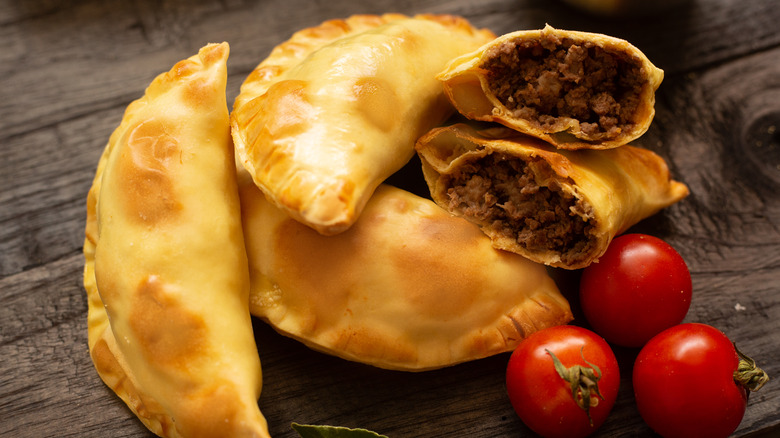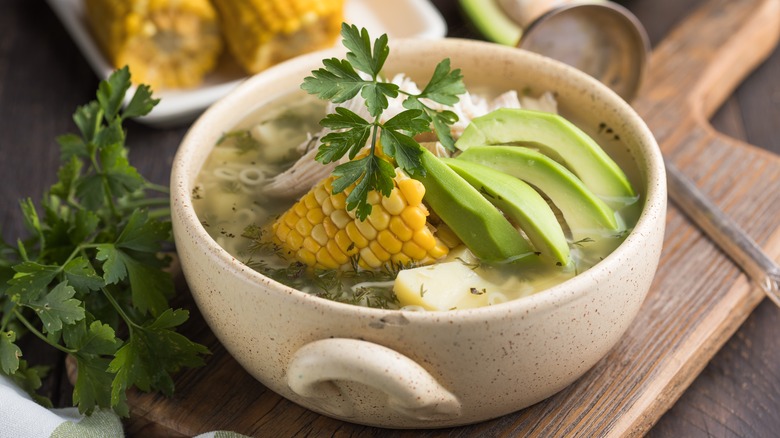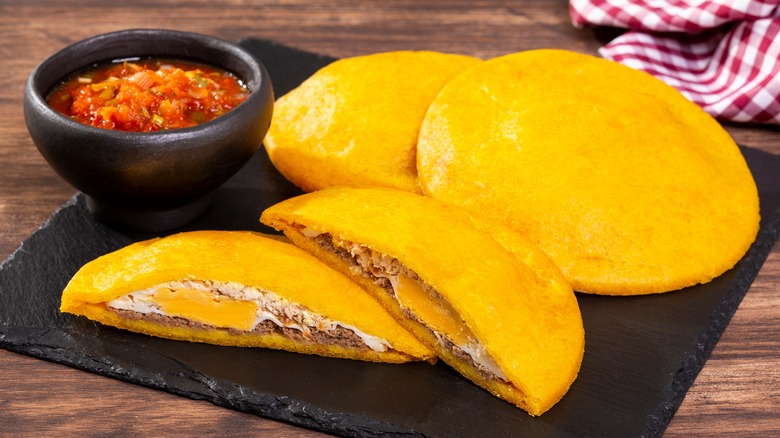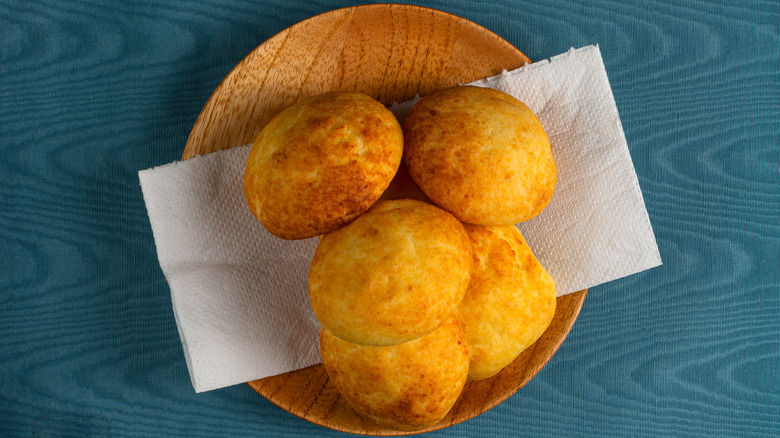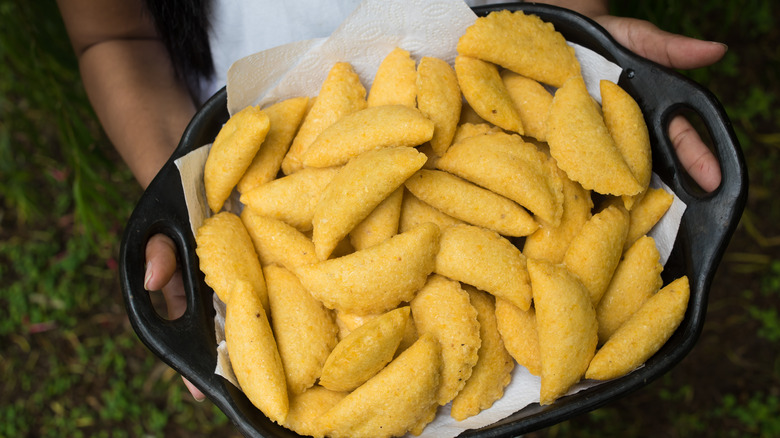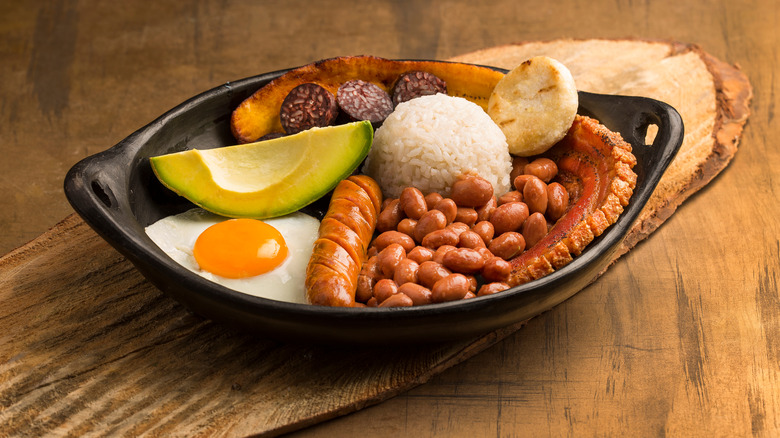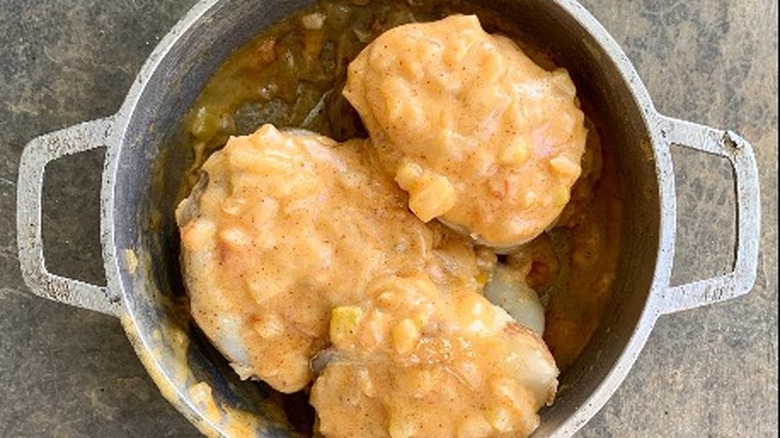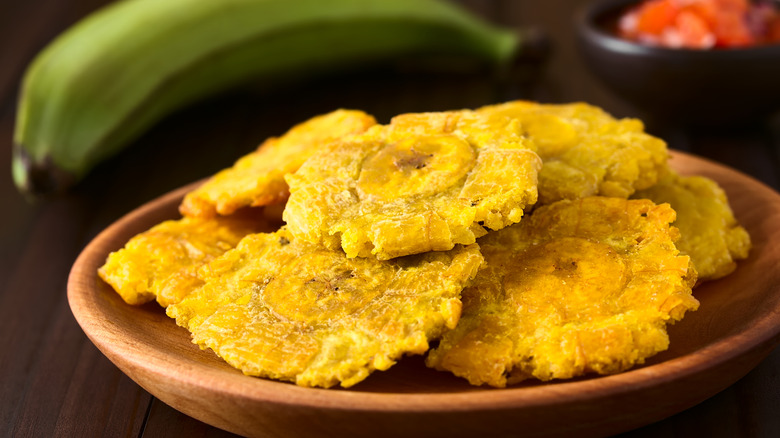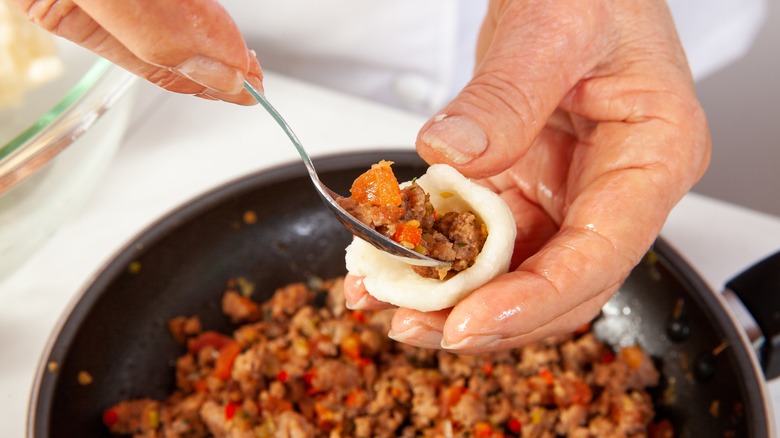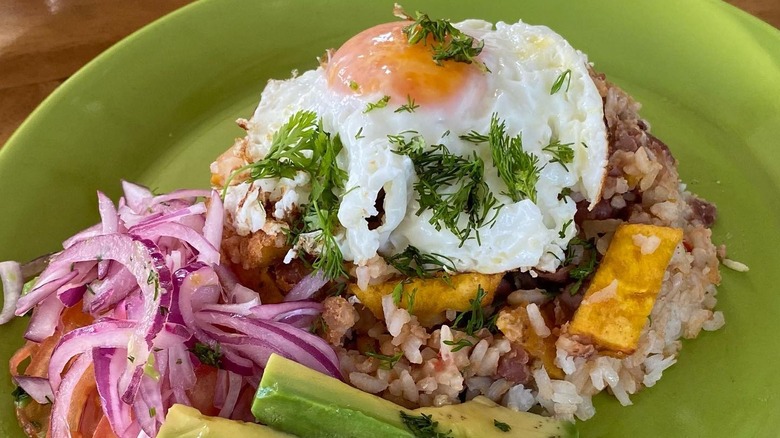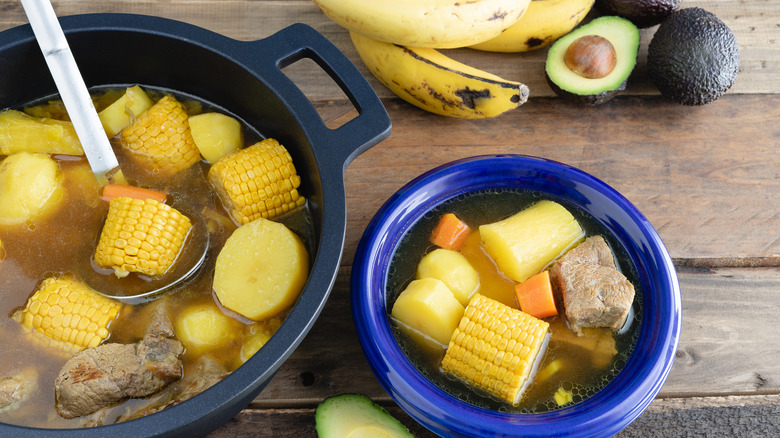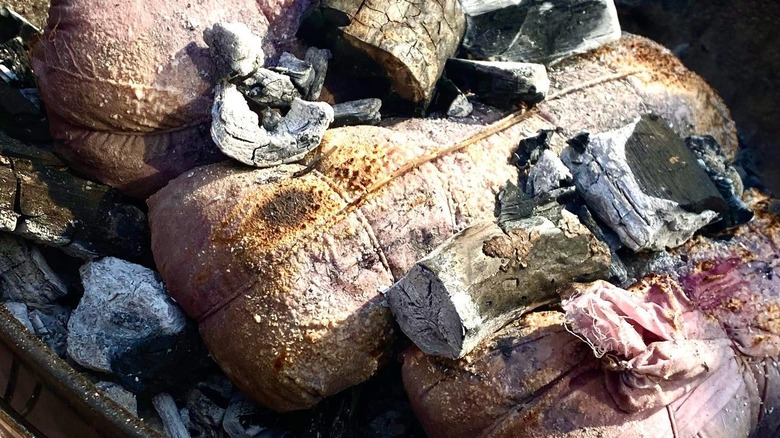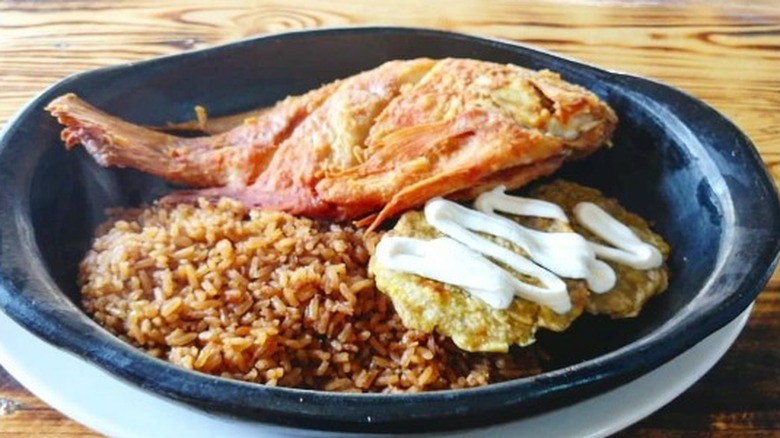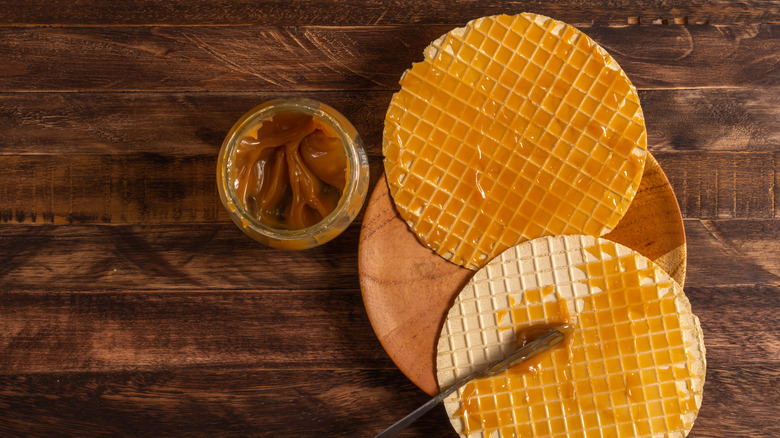13 Popular Colombian Foods You Have To Try At Least Once
From the vibrant flavors of the Caribbean coast to the potato-laden plates of the Andes, Colombian cuisine blends its rich cultural heritage with a range of distinct regional styles. Influenced by indigenous, Caribbean, African, and Spanish cooking, each diverse region and even some cities have their unique specialties to explore. Although Colombian food may not be as internationally well-known as some of its Latin American counterparts, this robust cuisine offers a wide variety of intriguing dishes to discover. We asked New York restaurateur and Colombian chef, Felipe Donnelly, to share his recommendations for the most popular Colombian foods he thinks you should try.
Chef Felipe and his wife, Tamy Rolfe, began hosting weekly supper clubs back in 2010 which quickly evolved into their first restaurant, Comodo, in the Soho neighborhood of New York City. They now have three restaurants celebrating Latin American and Mexican cuisines: Comodo, Disco Tacos, and James Beard award-nominated Colonia Verde as well as a catering business called Comparti. Chef Felipe's menus are largely inspired by his childhood travels throughout Spain, Brazil, and Mexico. Here are Chef Felipe's picks for popular Colombian foods you have to try at least once.
Ajiaco
Ajiaco is an heirloom potato stew with a chicken base that comes with sides of cream, avocado, pulled chicken, capers, and spicy aji. This cozy soup has specific ties to the Andean region of Colombia, which is home to the country's capital city of Bogotá, although different versions of this satisfying stew can be found in nearby countries such as Cuba and Peru. The climate and soil of this region combine to create the perfect growing conditions for potatoes, of which hundreds of varieties are grown throughout the area, notes Undercover Colombia. The hearty soup is ideal for the cooler temperatures experienced at these higher altitudes. To flavor the broth, a South American herb called guascas is commonly added to give the ajiaco its distinctive flavor (via Fork in the Road). The guascas herb grows abundantly in the Andes Mountains and is recognized for its savory and slightly minty notes. Although guascas is widely utilized in Colombian cooking from soups and stews to vegetable and meat dishes as well as herbal tea and beverages, it is best known for its inclusion in ajiaco. With its comforting ingredients and unique flavor profile, ajiaco is a famous Colombian dish that Chef Felipe says everyone must try once in their life.
Arepas
Although versions of arepas can be found in many countries across Latin America, the corn-based flatbreads are especially iconic to Colombian cuisine. In the pre-Colombian era, indigenous groups harvested corn and used it in many preparations, such as the precursor to modern-day arepas, as it was regarded as a gift from the gods (via Colombia.co). From savory to sweet, Chef Felipe explains, "Colombia has all types of different arepas, some are stuffed, many are topped with different ingredients, and the dough can also include cheese or not." There are over 40 types of these beloved corn cakes in Colombia, each reflecting the cities and regions in which they are found. One of the most famous is the arepa e' huevo, a fried yellow corn cake filled with a whole egg, that might be eaten at any time of the day. This dish is especially popular along the Colombian Caribbean coast, especially for travelers along the Troncal del Caribe highway. The tradition of preparing these savory arepas has been passed down through generations for nearly 200 years. Another popular type of arepa typically enjoyed for breakfast or as a late afternoon snack is the arepa de choclo. This sweet and salty arepa is made with tender corn and sometimes cheese with a preparation technique similar to pancakes.
Almojábanas
Almojábanas are a sweet cornbread that Chef Felipe calls out of this world. These small buns are made with cornmeal flour and cuajada white cheese to achieve a spongy texture with a golden brown finish, notes Taste Atlas. This very traditional Colombian bread has been prepared for generations and is deeply ingrained in the national culture. Like many Colombian foods, there are regional variations of almojábanas that can be found across the country including costeñas, valluna, and boyacense (via Colombia.com). Almojábanas costeñas have a sweet and salty contrast from the addition of costeño cheese and panela, a type of unrefined cane sugar commonly used in Central and Latin American cooking. Almojábana valluna combines corn and cassava or wheat starch to make a dough that is filled with curd rather than cheese, making it very distinct from other versions of this type of bread. Almojábana boyacense is set apart from the others by its use of queso campesino, a type of soft, peasant cheese.
Empanadas
Empanadas in Colombia differ from other types of empanadas you might find across South or Central America. Rather than the typical flour dough, Colombian empanadas are made with corn dough and are usually stuffed with minced meat and potatoes, although vegetables or fruits may also appear in the fillings. The City Paper Bogota traces the long and unexpected history of the empanada from ancient regions of the Middle East to North Africa and all the way to the Americas. Now one of the most popular street foods in Bogotá, the empanada is believed to have originated in the heart of Mesopotamia where it has since been altered and refined over time as it made its way across the world. These fried or baked stuffed snacks combine elements of three of the country's main cultures: indigenous, Creole, and Afro-Colombian (via Colture). The main ingredient, corn, was grown by indigenous tribes, the filling is derived from Creole cooking, and the deep frying technique came from the Afro-Colombian influence. Once reserved as a special holiday treat, empanadas are now enjoyed throughout the year for practically any occasion with a wide variety of traditional, regional, and modern variations to choose from.
Bandeja Paisa
A traditional dish from the Paisa region of Antioquia, bandeja paisa is characterized by its variety and abundance. The name loosely translates to "farmer's tray" and reflects the generosity, hospitality, and community of the Colombian people (via Impulse Travel). The hearty dish typically includes rice, black or red beans, fried plantains, chicharron, chorizo and blood sausages, ground beef, an arepa, and a fried egg along with other accompaniments such as salsa, avocado, tomato, and salad. There are competing stories regarding the origin of this generous plate. Some say that people from the region just loved eating food or it grew from traditional stewed meat and rice dishes. Another story ascribes its creation to a restaurant owner from Bogotá who was inspired by guests perusing a buffet of Antioquian cuisine and decided to create a dish served on a plate that was large enough to include all the different components. Regardless of its origin, bandeja paisa is a classic Colombian dish that is meant to be shared and enjoyed along with good company.
Papas Chorreadas
Papas chorreadas is another beloved Colombian dish that celebrates the native potato. Especially popular across the Andean regions of the country, Chef Felipe describes the dish as "small heirloom potatoes with a creamy sauce" that are wholly or partially peeled, boiled, and topped with melted cheese and a special sauce called hogao. The word chorrear means to pour or flow, referring to the rich sauce that is poured over the potatoes, says Taste Atlas. Other ingredients may include cumin, butter, fresh cilantro, or crumbled bacon, but the hogao is a must. Hogao is a simple sofrito consisting of diced tomatoes, onions, cilantro, and garlic that is served as an accompaniment to a variety of Colombian dishes such as stewed or grilled meats, arepas, bandeja paisa, or rice as a seasoning, dip, or topping. Papas chorreadas are most often enjoyed as a comforting side dish with grilled chicken or steak.
Patacones Pisao
The strong culinary influence of the Caribbean is particularly evident in patacones pisao, fried plantain discs often served with a side of hogao for dipping. Similar to the tostones, fritos, or platanos found across the Caribbean and other regions of Latin America, green plantains are fried, smashed, and then fried again to achieve the distinct, crispy texture of this beloved dish (via Greatist). The star of the dish is the green plantain with its neutral flavor and a starchy texture ideal for deep frying. Many dishes across Colombian cuisine include bananas and plantains that are boiled, roasted, stewed, or included in soups, but most often they are fried to make patacones. To make patacones, the plantains are peeled and cut to shape and size, then dropped into hot oil for their first fry. After their first dip in the deep fryer, the plantains are smashed and coated in a garlic and salt water mixture before heading back into the oil for a second fry which gives them their distinctive color and crunchy texture. Patacones pisao are especially popular in coastal cities like Cartagena where they are eaten at breakfast, lunch, or dinner along with hogao or suero, a fermented dairy condiment similar to sour cream.
Carimañolas
The release of Disney's Encanto put the global spotlight on Colombian culture as the film's creators traveled across the regions from Cartagena to Bogotá to help them infuse the animated movie with authentic details of the country's diverse geography, music, people, folklore, and food, reports Condé Nast Traveller. This growing interest in Colombian cuisine allows even more opportunities for chefs like Felipe Donnelly and Valentin Mussi to share their heritage and traditional recipes. Carimañolas are a street food popular along the Caribbean coast that are made with cassava (also called yuca, not to be confused with yucca) that is stuffed with either ground meat and vegetables or cheese. The cassava root (or yuca) is peeled, boiled, and smashed to make the dough which is then filled, shaped, and traditionally deep fried. Carimañolas are typically torpedo or ball-shaped and served with a vibrant aji sauce (so delicious).
Calentado
Nothing is wasted when it comes to calentado, a traditional Colombian breakfast consisting of reheated leftovers from the night before. Chef Felipe describes this dish as "pure comfort food" with each household having its own unique combinations of components. Calentado is undoubtedly one of the best ways to use leftover rice, transforming it into a colorful feast of flavors and textures. The Antioquia region features some of the locals' favorite ingredients such as rice, beans, and steak, which are commonly eaten for dinner, then reheated as part of this hearty breakfast. Stemming from a frugal past when much of the population of Colombia lived in poverty, calentado was born from necessity, but now, with more access to refrigeration, it has become an abundant meal typically served on the weekends along with coffee or hot chocolate (via Taste Atlas). There's no real recipe for calentado since all you have to do is reheat, but this hearty breakfast may include rice, beans, plantains, steak, fried eggs, arepas, sausages, chicharrónes, and potatoes, seasoned or served with hogao.
Sancocho
Sancocho is a comforting stew that inspires memories of home and family for many Colombian people, and the ingredients for sancocho vary, reflecting the region in which it is made. A protein such as beef, chicken, or fish is simmered with starchy vegetables such as potatoes, green plantains, Andean corn, or cassava (via The City Paper Bogota). This hearty stew is often prepared on the weekend and can stretch a few pieces of meat and some vegetables into a meal that will feed even a large family. Sancocho also reflects Colombia's historic, cultural, and culinary ties to Africa as the dish is believed to have originated in the Canary Islands. As Spaniards brought their version of sancocho to the New World, Colombian cooks incorporated local ingredients to create their version of the celebrated stew. There is not one set recipe for sancocho with each family having their version passed down through generations. Chef Felipe's favorite sancocho is a thick bone broth of chicken, beef, and pork mixed with yuca, rice, and heirloom potatoes topped with hogao.
Lomo al Trapo
Like in many South American cultures, Colombian people are experts at preparing smoky, succulent fire-grilled meats, and when it comes to lomo al trapo, Chef Felipe is certain you have never tasted steak like this before. Lomo al trapo is more of a technique than a recipe, in which a salt-encrusted beef tenderloin is wrapped in a towel or cheesecloth and cooked directly in the hot embers of a fire. Barbecue enthusiast Steven Raichlan, who has studied and written about live-fire grilling for over fifteen years, told Smithsonian Magazine, "Colombia has some of the most amazing barbecue in South America." The meat is rich and full of flavor that is arguably better than the renowned versions from Uruguay, Argentina, and Brazil, possibly thanks to Colombia's cooler climate, which affects the taste and texture of the beef. Its unique, primal, and mouth-watering technique makes lomo al trapo a must-try Colombian food.
Arroz con Coco
Another must-try Colombian dish that deeply reflects the Caribbean influence on Colombian cooking, as well as its Spanish, African, and indigenous influences, is arroz con coco. Popular in cities like Cartagena, this signature coastal dish is made by cooking white rice with fresh coconut milk, coconut meat, water, salt, sugar, and sometimes raisins (via Amigo Foods). Differentiating it from other versions of coconut rice from across Asia or Africa, the technique for preparing Colombian arroz con coco includes reducing and browning the coconut milk and coconut meat to create a distinct flavor and texture in the rice. Once the coconut milk has solidified in the bottom of the pan, the rice is added and steamed with additional coconut milk and water, during which the arroz con coco gains its signature golden brown color. This versatile dish can be made either savory or sweet and is typically served as a side dish to highlight the flavors of seafood or as a sweet, tropical dessert.
Oblea con Arequipe
Oblea con arequipe is a signature dessert made with two super thin wafers and arequipe, a caramel-like dip or spread that Chef Felipe calls Colombia's very own version of dulce de leche. Obleas have a history as a close relative of the communion wafer, ice cream cones, waffles, and the Dutch stroopwaffel with variations that can be found across the world, especially throughout Latin America, reports Anglo Info. The sweet snack is frequently found at street stands across Colombia and has become a popular treat in the country since the 1940s when the first oblea factory was established in Santander (via Taste Atlas). Depending on the region, obleas might be eaten by purchasing a stack of wafers and jars of toppings to use as dips or spreads, or the luscious fillings might be sandwiched between two of the thin obleas. Other oblea spreads include fruit jams, grated cheese, chantilly cream, or chocolate sprinkles, but the arequipe is a perfect combination with the delicate pastry wafers that makes it a must-try Colombian food.
